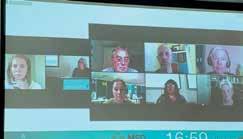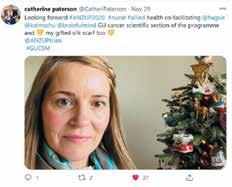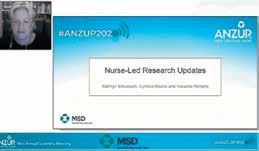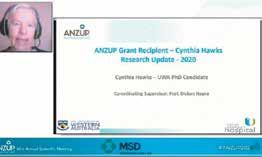
4 minute read
Finding a clinical pathway during a pandemic
Finding a clinical pathway in the face of a pandemic

The emergence of COVID-19 has had a large impact on people living with cancer, on healthcare professionals (HCP), and also the delivery of health services. Every day new information is released regarding COVID-19. This then leads to the rapid development, sharing and implementation of new health regulations. Oncology services have been affected globally, and this has included the speedy transition to telehealth.
Worldwide, various strategies have been implemented to help alleviate and contain the spread of COVID-19. This has included social distancing and the introduction of quarantining. For those living with below the belt cancers, these measures have sometimes led to distress, increased risk of depression, and social isolation. Consideration is being taken and regularly reviewed for cancer patients but little is known about the experiences among frontline nurses and allied healthcare professionals who care for the patients affected by below the belt cancer. More needs to be discovered about the day-to-day service delivery as well as the nurses and allied healthcare professionals experience addressing the needs of people affected by cancer.
Australia has fortunately experienced lower infection rates in comparison to other countries. Despite this, the impact has been felt across staff and patients in cancer services. As healthcare professionals continue to respond, the opportunity to innovate quickly has been embraced by healthcare leaders. ANZUP recently held its Annual Scientific Meeting and included a session for nurses and allied healthcare professionals titled, ‘In the Face of a Pandemic, Navigating a Clinical Pathway.’ This session was used to explore the experiences of nurses and allied health professionals caring for people affected by below the belt cancers during the COVID-19 pandemic as well as the impact on people living with cancer and the delivery of healthcare services, particularly the transition to telehealth and teletrials.

A lot of productive discussion occurred throughout the meeting and many points were raised in relation to both cancer patients and healthcare staff.
It was reported that many patients benefited from telehealth and not having to travel during the height of the pandemic. Anxiety levels were lessened as well as the financial burden of travel – especially if journeying from a rural or regional location.
Not all patients embraced telehealth – either due to IT limitations in rural areas or lack of experience and confidence using technology. Healthcare staff felt they became IT instructors, coaching their patients through set up and use of their mobile device or computer prior to a consultation.

Communication skills also had to be adjusted during telehealth appointments. Nurses and allied healthcare professionals had to become skilled at interpreting patient responses, body language and reactions during the appointments. They also had to learn to feel comfortable delivering bad news not in a face to face setting. Some patients benefited receiving unexpected results at home. They avoided having to travel after receiving unfavourable news and could process their results in the comfort of their own homes.

Another change in practice during the pandemic was increased involvement of general practitioners (GPs) and nursing services at home. It was noted that GP services are under-utilised and are a vital link, especially in the rural setting. They are a resource that should be included in the clinical treatment pathway moving forward. However, many GPs were also having to convert to telehealth appointments so it will be important, when engaging them in a clinical trial and cancer treatment via telehealth, that it does not become a burden on their time.
Overall, many positives have come from the revised consultation and treatment pathway. Discussion centred around possibly changing patient care permanently and maintaining telehealth and teletrials - not just now but when the pandemic is over. Integrated and shared care models with primary care and nurse involvement is a definite benefit not previously explored. Communication skills may need to become more of a focus for healthcare staff, and the digital literacy of the patient and caregiver will be an ongoing process. But most importantly is consideration of the patient – do they only want telehealth consultations, do they prefer face to face appointments, or is a hybrid of the two the ultimate solution.



“One of the discussion points that has been highlighted is the benefits of telehealth and an integrated approach with primary care and community nursing for the patient”. Associate Professor Haryana Dhillon
Further work and research is being undertaken to try and establish a workable clinical pathway during a pandemic that is beneficial to cancer patients and nurses and allied healthcare professionals. Findings from this research will be presented at relevant scientific meetings and submitted for publication in a peer-reviewed journal.
DO DO YOU HAVE YOU HAVE A STORY A STORY YOU COULD SHARE WITH OTHERS? YOU COULD SHARE WITH OTHERS?
Share your story with us here anzup@anzup.org.auShare your story with us here anzup@anzup.org.au Create awareness and let others Create awareness and let others know they are know they are not alone.not alone










